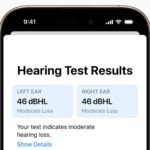
Apple is expanding the features of the AirPods Pro 2 to include a clinically validated hearing test and a “real” hearing aid function. The company promises support for moderate hearing loss and is setting new standards in personal audio and sound experience.
Let’s not kid ourselves: Some people have noticed major changes in their hearing over time – and club music over the last 40 years has contributed to this. “Hearing loss” is therefore not just a problem in retirement – and Apple is now thinking about all of these cases.
Apple is planning to fundamentally expand the hearing health area with an upcoming software update for the AirPods Pro 2. As the company announced at the iPhone event, the headphones will soon be supplemented with a clinically validated hearing test and a hearing aid function. These innovations are intended to offer better support to users with moderate hearing loss.
The new integrated hearing test, which Apple says takes about five minutes, uses the combination of AirPods and iPhone. The results are then saved in the Health app and form the basis for personalized audio adjustments. If hearing loss is detected, users can then use the new hearing aid mode.
In this mode, the AirPods Pro 2 automatically adjust the audio output to the user’s individual hearing profile. This applies both to dealing with ambient noise and to playing media content such as music or podcasts. In terms of performance, Apple describes this function as “clinical quality” for moderate hearing loss.
The innovations are based on an extensive hearing study by Apple, in which over 160,000 participants were involved. Apple had already published some Findings published. Video: Hearing test, hearing aid function & hearing protection for the AirPods Pro 2
This underscores the company’s long-standing commitment to hearing health. But Apple is taking this a step further, because what will now be available is an over-the-counter, professional hearing aid feature. This feature amplifies the specific types of sounds that you need help with on a personal level.
This is a big step, as over-the-counter hearing aids can cost between $1,000 and $1,500 in the U.S. The second-generation AirPods Pro, by comparison, cost just $250 and can provide comparable support, according to the marketing promise.
In addition to the hearing aid feature, Apple is also introducing a hearing protection mode. This mode uses machine learning to automatically detect and attenuate loud noises to prevent hearing damage. Apple plans to roll out these new features in over 100 countries. However, approval from the FDA and other regulatory authorities is still pending, so no release date has been set. The company expects the update to launch later this year. In any case, it will be available for free to AirPods Pro 2 users.
According to the World Health Organization (WHO), around 430 million people worldwide suffer from hearing loss. In Germany, an estimated 16 million people are affected. Traditional hearing aids are often expensive and stigma-laden, which prevents many people from using them. Apple’s approach could offer a low-threshold alternative.
Category Statistics
| Global prevalence | Approximately 1.1 billion young people (12-35 years) worldwide are at risk of hearing loss |
| Cause: Noisy environments | Approximately 50% of adolescents and young adults (12-35 years) are exposed to dangerously high noise levels in leisure environments |
| Cause: Personal audio devices | About 40% of 12- to 35-year-olds in middle- and high-income countries are exposed to potentially harmful sound levels from personal audio devices |
| Early hearing loss | An estimated 1 in 5 young people suffer from some form of hearing loss |
| Increase in recent years | The rate of hearing problems among adolescents has increased by about 30% in the last 30 years |
Integrating health features into everyday devices is a growing trend in the technology industry. Apple has been investing heavily in health features in recent years, from the ECG feature in the Apple Watch to fall detection in iPhones.